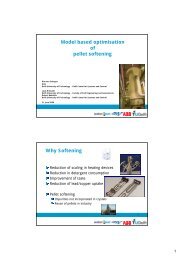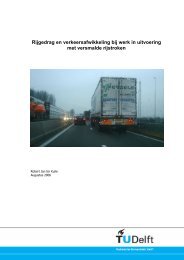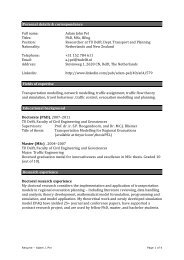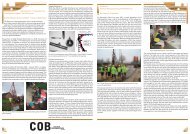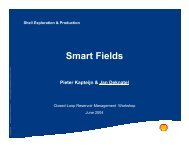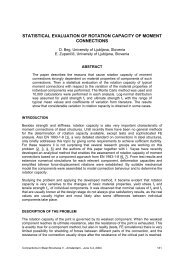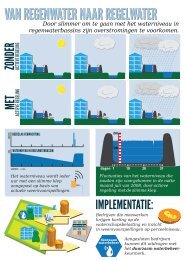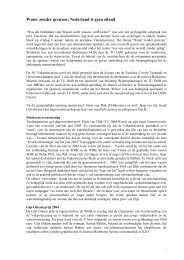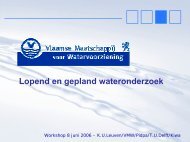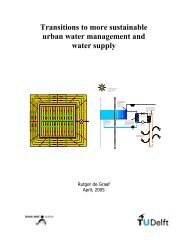Research on pedestrian traffic flow in the Netherlands - TU Delft
Research on pedestrian traffic flow in the Netherlands - TU Delft
Research on pedestrian traffic flow in the Netherlands - TU Delft
Create successful ePaper yourself
Turn your PDF publications into a flip-book with our unique Google optimized e-Paper software.
Daamen, W, & Hoogendoorn, SP (2003). <str<strong>on</strong>g>Research</str<strong>on</strong>g> <strong>on</strong> <strong>pedestrian</strong> <strong>traffic</strong> <strong>flow</strong>s <strong>in</strong> <strong>the</strong> Ne<strong>the</strong>rlands. In<br />
Proceed<strong>in</strong>gs Walk 21 IV (pp. 101-117). Portland, Oreg<strong>on</strong>, United States: Walk 21 c<strong>on</strong>ference.<br />
<str<strong>on</strong>g>Research</str<strong>on</strong>g> <strong>on</strong> <strong>pedestrian</strong> <strong>traffic</strong> <strong>flow</strong> <strong>in</strong> <strong>the</strong> Ne<strong>the</strong>rlands<br />
W<strong>in</strong>nie Daamen<br />
Serge P. Hoogendoorn<br />
Introducti<strong>on</strong><br />
Designers of walk<strong>in</strong>g <strong>in</strong>frastructure such as transfer stati<strong>on</strong>s, city center areas and shopp<strong>in</strong>g<br />
malls need to assess <strong>the</strong> quality of <strong>the</strong> plans. C<strong>on</strong>sequently, tools are needed, such as<br />
microscopic and macroscopic <strong>pedestrian</strong> <strong>flow</strong> models, as developed by <strong>the</strong> Transportati<strong>on</strong><br />
and Plann<strong>in</strong>g Secti<strong>on</strong> of <strong>the</strong> <strong>Delft</strong> University of Technology. Before <strong>the</strong> simulati<strong>on</strong> models<br />
can be applied <strong>in</strong> practice, <strong>the</strong>y must be calibrated and validated. In order to do this, as well<br />
as to ga<strong>in</strong> more <strong>in</strong>sight <strong>in</strong>to <strong>pedestrian</strong> behavior under different c<strong>on</strong>diti<strong>on</strong>s, very detailed<br />
empirical data are required. Also, <strong>the</strong>se data are used to fill exist<strong>in</strong>g gaps <strong>in</strong> knowledge <strong>on</strong><br />
<strong>pedestrian</strong> behavior. <strong>Delft</strong> University of Technology has recently carried out a number of<br />
<strong>pedestrian</strong> <strong>flow</strong> experiments. Fur<strong>the</strong>rmore, observati<strong>on</strong>s have been performed of <strong>the</strong> board<strong>in</strong>g<br />
and alight<strong>in</strong>g process <strong>in</strong> Dutch railway stati<strong>on</strong>s.<br />
Large-scale experimental research <strong>on</strong> <strong>pedestrian</strong> <strong>flow</strong>s has not been performed before. Not<br />
<strong>on</strong>ly <strong>pedestrian</strong> research <strong>in</strong> <strong>the</strong> form of experiments is an important <strong>in</strong>novati<strong>on</strong>, also <strong>the</strong> scale<br />
of <strong>the</strong> experiments and <strong>the</strong> amount of very detailed data <strong>on</strong> <strong>in</strong>dividual <strong>pedestrian</strong>s is unique.<br />
Not <strong>on</strong>ly <strong>the</strong> observati<strong>on</strong> technology has unique aspects; also <strong>the</strong> software specifically<br />
developed for automated track<strong>in</strong>g of <strong>pedestrian</strong>s did not exist. Fur<strong>the</strong>r <strong>in</strong>novati<strong>on</strong>s <strong>in</strong> <strong>the</strong>ory<br />
are <strong>the</strong> development of optimal c<strong>on</strong>trol models and <strong>the</strong> descripti<strong>on</strong> of <strong>pedestrian</strong> behavior <strong>in</strong><br />
bottlenecks. F<strong>in</strong>ally, two simulati<strong>on</strong> models for <strong>pedestrian</strong> <strong>flow</strong>s have been developed, to<br />
describe <strong>in</strong>dividual <strong>pedestrian</strong> behavior (NOMAD) and to describe <strong>pedestrian</strong> <strong>flow</strong>s <strong>in</strong><br />
transfer stati<strong>on</strong>s, <strong>in</strong>clud<strong>in</strong>g <strong>the</strong> <strong>in</strong>teracti<strong>on</strong> with public transport vehicles (SimPed).<br />
In this paper, first a short overview is given of <strong>the</strong> research performed at <strong>the</strong> <strong>Delft</strong> University<br />
of Technology. Then, we focus <strong>on</strong> several parts of this research. More detailed <strong>in</strong>formati<strong>on</strong> is<br />
given of observati<strong>on</strong>s of board<strong>in</strong>g and alight<strong>in</strong>g at Dutch railway stati<strong>on</strong>s, laboratory walk<strong>in</strong>g<br />
experiments, <strong>the</strong> microscopic simulati<strong>on</strong> model NOMAD and <strong>the</strong> macroscopic simulati<strong>on</strong><br />
model SimPed.<br />
Overview of <strong>the</strong> research performed at <strong>the</strong> <strong>Delft</strong> University of Technology<br />
In general <strong>the</strong> research lifecycle of physical, psychological, or biological phenomena<br />
<strong>in</strong>volves <strong>the</strong> follow<strong>in</strong>g stages:<br />
• Empiricism<br />
• Theory<br />
• Models<br />
103



